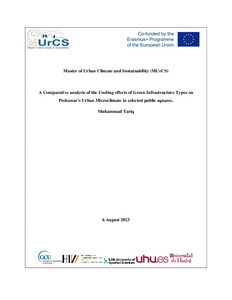A Comparative analysis of the Cooling effects of Green Infrastructure Types on Peshawar's Urban Microclimate in Public Squares
Tariq, Muhammad (2023)
Tariq, Muhammad
2023
All rights reserved. This publication is copyrighted. You may download, display and print it for Your own personal use. Commercial use is prohibited.
Julkaisun pysyvä osoite on
https://urn.fi/URN:NBN:fi:amk-2023101327506
https://urn.fi/URN:NBN:fi:amk-2023101327506
Tiivistelmä
This thesis conducts a comparative analysis of the cooling effects of green infrastructure (GI) types in Peshawar's urban microclimate, with a focus on three selected public squares. Utilizing Land Surface Temperature data, on-site microclimate measurements, ENVI-met simulations, and NDVI maps, the study reveals the unique interplay between different GI features
Three sites with varying green infrastructure (GI) types were selected to study temperature variations on different days during summer, with the goal of identifying effective GI types to mitigate Urban Heat Island (UHI) effects. The research found that a well-planned integration of specific tree types with an innovative approach to fountains could significantly reduce temperatures by up to 6°c compared to surrounding areas, while grass exhibited minimal ecological & cooling benefits ranging from 0.4 to 0.8 °c. These findings not only contribute to the existing body of knowledge on the role of GI in UHI mitigation but also offer practical tools for public authorities and designers. A unique outcome of this study is the development of a simple PeshawarTreeFinder mobile app, aimed at assisting stakeholders in carefully selecting the appropriate GI type for square typology. This resource will be distributed to stakeholders and consultants for free usage, emphasizing the real-world applicability of the research. The study also highlights the importance of consultation with city authorities and public engagement, uncovering insights such as budget constraints affecting fountain operation, which informed the research and underscores the need for a comprehensive understanding of local context in GI implementation
Three sites with varying green infrastructure (GI) types were selected to study temperature variations on different days during summer, with the goal of identifying effective GI types to mitigate Urban Heat Island (UHI) effects. The research found that a well-planned integration of specific tree types with an innovative approach to fountains could significantly reduce temperatures by up to 6°c compared to surrounding areas, while grass exhibited minimal ecological & cooling benefits ranging from 0.4 to 0.8 °c. These findings not only contribute to the existing body of knowledge on the role of GI in UHI mitigation but also offer practical tools for public authorities and designers. A unique outcome of this study is the development of a simple PeshawarTreeFinder mobile app, aimed at assisting stakeholders in carefully selecting the appropriate GI type for square typology. This resource will be distributed to stakeholders and consultants for free usage, emphasizing the real-world applicability of the research. The study also highlights the importance of consultation with city authorities and public engagement, uncovering insights such as budget constraints affecting fountain operation, which informed the research and underscores the need for a comprehensive understanding of local context in GI implementation
